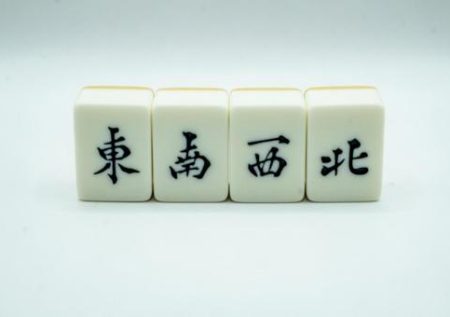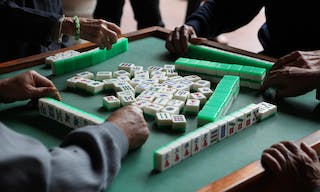


Mahjong is generally divided into five categories of tiles: “Characters, Circles, Bamboos, Honors, and Flowers”.
The Character, Circle, and Bamboo tiles consist of numbered tiles from one to nine, while the Honors tiles include “East, South, West, North” and “Red, Green, White”. Lastly, there are eight flower tiles, which are “Spring, Summer, Autumn, Winter” and “Plum, Orchid, Chrysanthemum, Bamboo”. Modern Mahjong Gameplay A regular Mahjong game is based on the unit called “one bird”. “One bird” consists of “four rounds”, which are “East round, South round, West round, North round”, with each round containing four sets.
The first round of a Mahjong game is called “East round” and the player seated in the East position becomes the dealer. If no player wins during the dealer’s turn (a draw), or if the dealer wins, they will become the dealer again. After all players complete four rounds of play, it is considered the end of “one bird”.
A complete set of modern Mahjong tiles consists of 144 tiles, including nine Character, Circle, and Bamboo tiles, three sets of Honor tiles (“East, South, West, North”, “Red, Green, White”), and eight Flower tiles (“Spring, Summer, Autumn, Winter”, “Plum, Orchid, Chrysanthemum, Bamboo”).
Before the game starts, the seating positions should be determined. Players can compete for the “East, South, West, North” tiles from the Mahjong set and each player draws one tile, seating according to the tile drawn. The player seated in the South position is called “South”, the one on the left is “North”, and the opponent is “West”. The order of play is counterclockwise, so the player on the left is also referred to as “Upper Player”, and the player on the right is called “Lower Player” or “House”.
Mahjong is a game where players must quickly form specific combinations of tiles to determine a winner. While forming their own combinations, players also need to analyze and block their opponents. The specific tile combinations include “Four sets of Triplets (Pongs)”, “Sequences” (e.g., 40000, 50000, 60000), “Four of a Kind” (four identical tiles), and one pair of “Eyes”. During the drawing and discarding process, players continuously adjust the combinations in their hands based on the tiles on the table in order to achieve a “Four-of-a-Kind” combination.
Pong: Forming a triplet with three identical tiles.
Chow: When a player can form a sequence with tiles of the same suit and consecutive numbers (e.g., 789 of one suit), they can call “Chow” and take the tile from the opponent.
Kong: If a player draws a tile that is identical to the three tiles they already have, they can declare a “Kong” (melded Kong). Alternatively, if a player has three identical tiles and draws the fourth identical tile, it is called a “Concealed Kong”. If another player discards the remaining tile needed for a Kong, it is called an “Open Kong”.
All Triplets: Four sets of Triplets with one pair of Eyes.
Mixed One Suit: All tiles except Honors belong to the same suit.
Big Three Dragons: Three sets of Dragon tiles (“Red, Green, White”), plus one set of tiles (meld or pong) and one pair of Eyes.
Small Three Dragons: Two sets of Dragon tiles (“Red, Green, White”), plus two sets of tiles (meld or pong) and one pair of Eyes.
Thirteen Orphans: One tile from each of the following: 1 and 9 of each suit, plus the Dragon and Honor tiles, and any pair of tiles as Eyes.
All Terminals: All tiles consist of 1s and 9s (in any suit).
Big Four Winds: One set of each Wind tile (“East, South, West, North”), plus one pair of Eyes.
Small Four Winds: Three sets of Wind tiles (“East, South, West, North”), plus one set of tiles (meld or pong) and one pair of Eyes.
All Honors: All tiles consist of Wind and Dragon tiles.

Seating
Before each round starts, players draw tiles representing “East, South, West, North” to determine their positions and seats.
Dealing
Before the game starts, the player in the East position rolls the dice to determine the dealer based on the number rolled.
Initial Deal
Start taking tiles from the right side of the stack in front of the dealer. For example, if the dice roll is 9, start with the 10th stack from the right, going counterclockwise from the dealer, taking two stacks (four tiles) at a time, until all four players have taken 16 tiles each. Finally, the dealer takes one additional tile, called the “door tile”.
Flower Exchange
If a player draws a “Flower tile”, they need to take out the same number of tiles from the back of the stack, going counterclockwise starting from the dealer. During the game, if a player draws a Flower tile while it is their turn to draw, it counts as a drawn tile. Winning from this tile earns one extra fan/point known as “Blossoming Flower”.
Drawing and Discarding
During the game, a player discards the tiles they do not need into the center, forming the “discard pile”. After discarding, if no player wants to “take” or “draw” the tile, the next player can draw from the stack until a player declares a winning hand or the game ends.
Winning Hand
If a skilled player’s discarded tile allows you to form a sequence (e.g., 789 of one suit), you can “draw” it, but only the discarded tile from the skilled player.
Pong
If any player discards a tile that allows you to form a triplet, you can “pong” that tile.
Kong
If you already have three identical tiles and draw another one, you can “kong” it, followed by drawing an additional tile. Kong can be declared as “Open Kong” (from any player’s discard) or “Concealed Kong” (from your own hand). If the remaining tile is discarded by another player, it becomes an “Exposed Kong”.
Ready Hand
When only one more tile is needed to complete a winning hand, it is called being in a “Ready Hand” or “Waiting”.